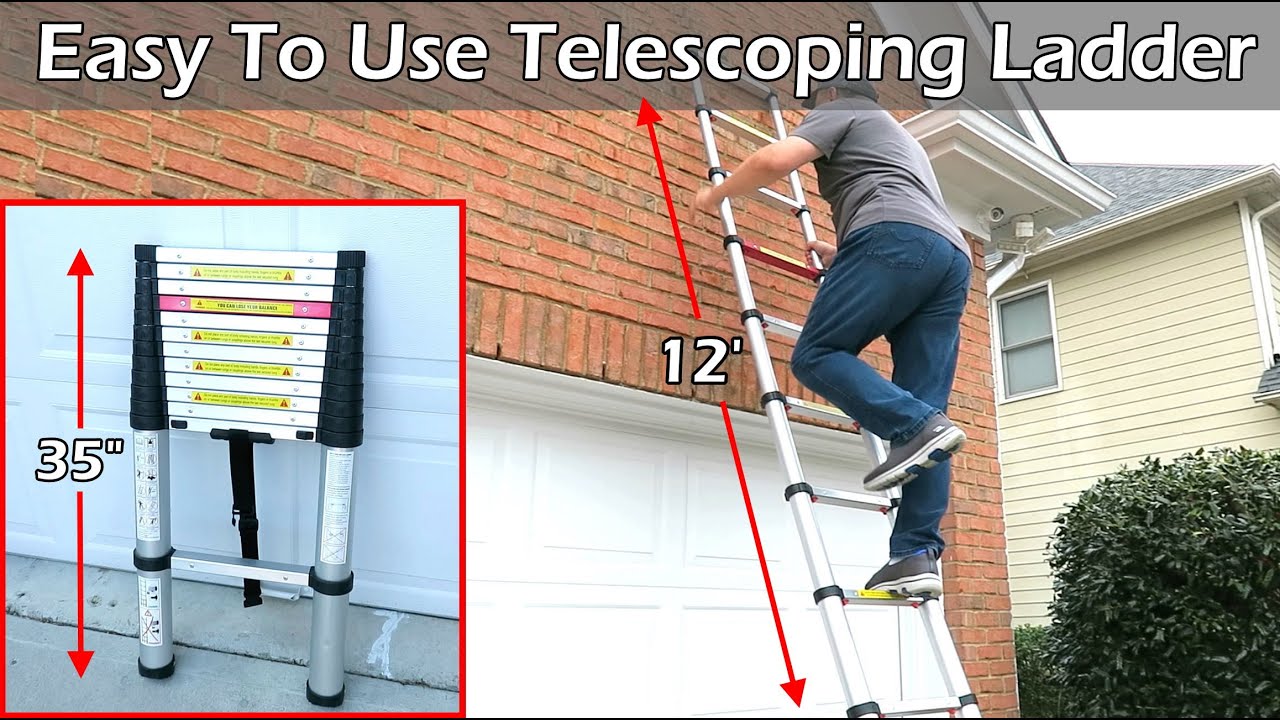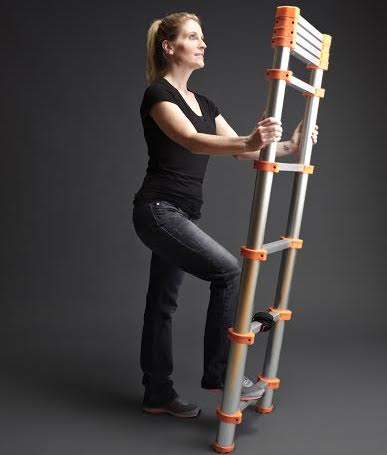How to Use a Telescoping Ladder?

To use a telescoping ladder, fully extend it, ensure all rungs are locked in place, and lean it securely against a stable surface. Always maintain a firm grip as you climb or descend the ladder.
A telescoping ladder is a versatile and portable tool that can extend to various heights, making it ideal for both indoor and outdoor tasks. Its compact design allows for easy storage and transportation. To utilize a telescoping ladder safely, one must follow specific procedures: place the ladder on a firm, level base, and secure its feet to prevent slipping.
Before ascending, double-check that each section is locked properly to avoid collapse. Remember to abide by the ‘belt buckle rule,’ keeping your center of mass within the ladder’s rungs to maintain balance. Careful adherence to manufacturer guidelines and safety standards will ensure that your use of a telescoping ladder is both efficient and safe.
Safety First: Preparing To Use A Telescoping Ladder
When it’s time to reach new heights, a telescoping ladder is a handy tool. However, safety is crucial before stepping up. Follow these guidelines to ensure a safe and secure experience.
Inspecting The Ladder Before Use
Always inspect your telescoping ladder before climbing. Look for these key aspects:
- Check for damage: No bends, cracks, or broken parts.
- Mechanism functionality: Ensure locking mechanisms fully engage.
- Clean rungs: Wipe down to prevent slipping.
Choosing A Suitable Location
Finding the right spot is essential for ladder stability and safety. Make sure to:
- Find level ground: Unsteady ground leads to accidents.
- Avoid hazards: Keep clear from overhead power lines and doors.
- Secure placement: Ensure the ladder’s feet are firmly on the ground.

Credit: www.amazon.com
Setting Up Your Telescoping Ladder
Setting up your telescoping ladder is a task that requires careful attention. The right setup ensures your safety while using the ladder. Whether you’re a professional or a DIY enthusiast, follow these steps to extend and secure your telescoping ladder properly.
Extending The Ladder Securely
Follow these steps to extend your telescoping ladder:
- Place the ladder on a stable, flat surface.
- Stand it up against a solid support, ensuring it’s upright and steady.
- Begin extending the ladder from the bottom, ensuring each rung clicks into place before moving to the next.
- Continue until you reach the desired height, always keeping your hands on the side rails and not the rungs to prevent pinching.
- Check every rung to ensure it’s fully extended and locked in place.
Locking Mechanisms And Safety Features
Once extended, engage the locking mechanisms:
- Identify the locking tabs or levers at each step.
- Push each one down or into the locked position, confirming the locking action with a visible or audible click.
- Make sure all locks are fully engaged before climbing the ladder.
Telescoping ladders typically feature safety indicators. Look for:
- Color indicators signaling that the rung is locked.
- Anti-pinch features to protect your fingers.
- Non-slip feet for stability.
Always refer to the manufacturer’s manual for specific safety instructions.
Climbing The Telescoping Ladder
Climbing a telescoping ladder requires particular attention to safety and technique. These ladders offer convenience and versatility, but to prevent accidents, correct usage is key. Follow these essential steps to climb securely and confidently.
Proper Climbing Techniques
- Inspect the ladder for damage before climbing it.
- Ensure all sections are locked in place.
- Place the ladder on stable, even ground.
- Face the ladder when climbing or descending.
- Keep your body centered between the rails.
- Move slowly and deliberately.
Maintaining Three Points Of Contact
- Always keep two hands and one foot, or two feet and one hand, on the ladder.
- Do not carry objects in your hands while climbing.
- Use a tool belt or have an assistant pass items to you.
- Keep your grip firm and your balance steady.
- Pause to ensure stability if you feel unsteady at any point.

Credit: xtendandclimb.com
Working On A Telescoping Ladder
Using a telescoping ladder requires careful steps for safety and efficiency. This guide will show you how to work on a telescoping ladder safely.
Load Capacity And Tool Handling
Knowing the load capacity is crucial for your safety. Telescoping ladders have a specific weight limit. Never exceed this limit as it could lead to injuries. Ladder specifications list the maximum weight.
Keep your tools secure while on the ladder. Use a tool belt or a hanging bucket. This keeps your hands free to climb safely and prevents dropped tools from causing accidents.
- Check ladder specs for weight limit.
- Always stay within this limit, including tools.
Staying Centered And Balanced
Balance is key on a telescoping ladder. Stay centered between the rails. Keep your body straight and avoid leaning to the sides. This can cause the ladder to tip over.
Maintain three points of contact with the ladder at all times: two hands and one foot, or two feet and one hand.
| Tips for Balance |
|---|
| Stay within ladder rails |
| Don’t lean or reach out too far |
| Avoid sudden moves |
Storing And Maintaining Your Ladder
Storing and maintaining your telescoping ladder ensures safety and longevity. Proper care prevents accidents and damage. Learn the ins and outs of safely collapsing, cleaning, and inspecting your telescoping ladder. Keep it in tip-top condition with these simple yet essential steps.
Collapsing The Ladder Safely
The right way to close your ladder is crucial for safety. Follow these steps:
- Ensure the ladder is fully extended and on a flat surface.
- Stand to the side to avoid getting caught in the collapsing sections.
- Unlock each section from the bottom up. Press or slide the locking mechanisms.
- Allow each section to slowly slide down. Use controlled pressure to prevent snapping.
- Make sure all sections are fully collapsed. Confirm the ladder is locked in its closed position.
Cleaning And Inspecting After Use
Regular cleaning and inspections keep your ladder safe. Here’s how to do it:
- Clean with soapy water. Wipe down each rung to remove dirt and grime.
- Dry the ladder completely. Prevent rust and corrosion on metal parts.
- Check for damage. Look for bent sections, broken locks, or loose components.
- Inspect the feet. Ensure they’re intact and provide proper grip.
- Store the ladder in a dry, covered space to avoid weather damage.
marks each list item. Always close lists with .
| Task | Importance |
|---|---|
| Cleaning | High |
| Inspecting | Critical |
| Storing | Essential |

Credit: m.youtube.com
Frequently Asked Questions Of How To Use A Telescoping Ladder?
What Is A Telescoping Ladder?
A telescoping ladder is a collapsible ladder that extends and locks by the foot to a variety of heights. It provides versatile use with compact storage.
How Do You Safely Extend A Telescoping Ladder?
To safely extend a telescoping ladder, ensure it’s on level ground. Extend it from the bottom rung upward, making sure each section locks securely before proceeding.
What Are The Weight Limits For Telescoping Ladders?
Weight limits for telescoping ladders vary by model. Most can typically support up to 250-300 pounds. Always check the manufacturer’s specifications before use.
Can Telescoping Ladders Be Used On Stairs?
Telescoping ladders can be used on stairs with proper safety accessories or by ensuring stability on a flat, secure surface on each stair.
Conclusion
Mastering the use of a telescoping ladder is essential for both DIY enthusiasts and professionals. With practice, safety measures, and proper maintenance, your ladder will serve you well. Always prioritize stability and personal safety. Embrace these tips to ensure your jobs are completed efficiently and without incident.




